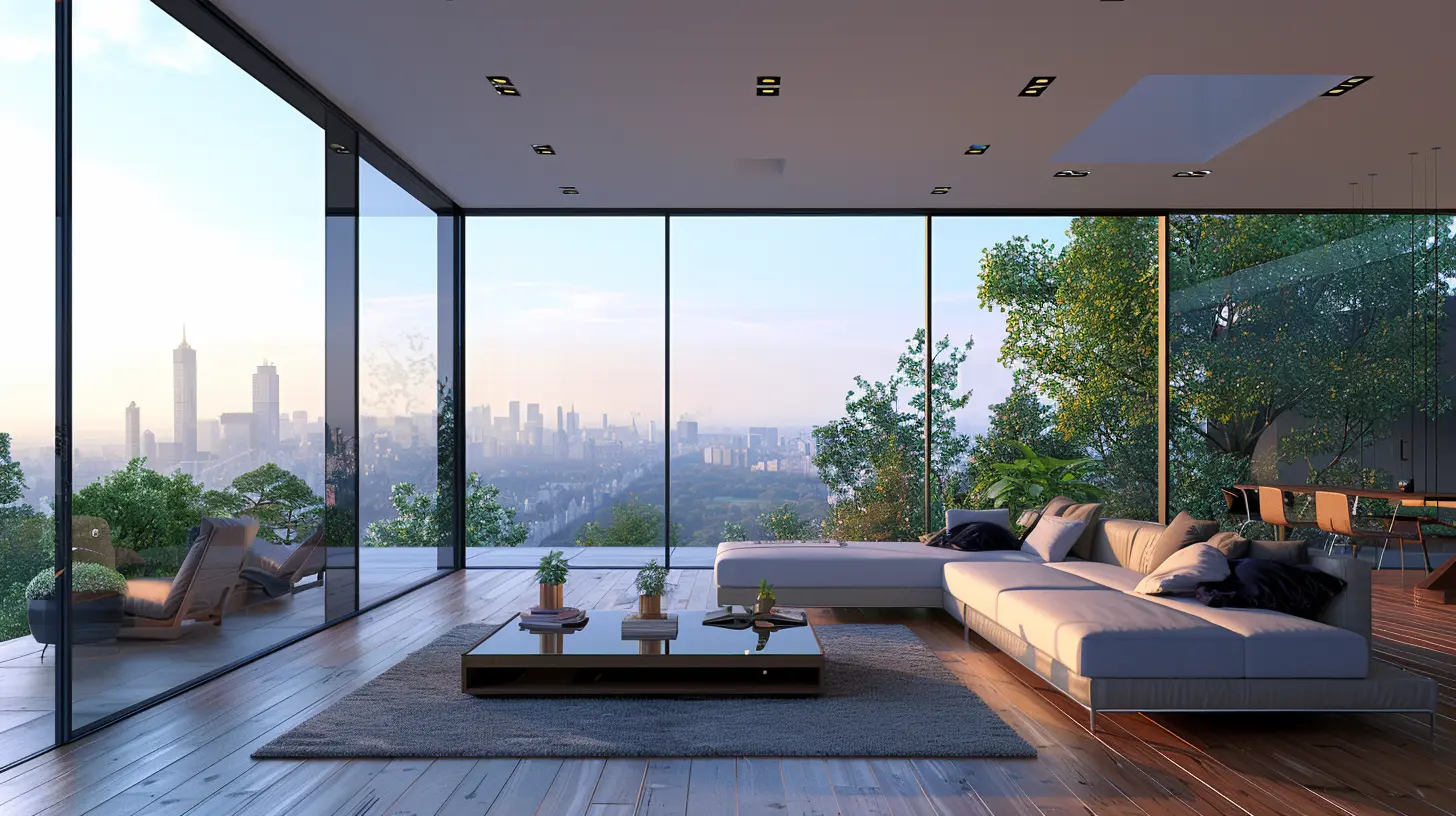How Augmented Reality is Disrupting the Real Estate Industry
23 July 2025
Imagine walking into your dream house without stepping outside your living room. Sounds like science fiction, right? Well, welcome to the future of real estate, where augmented reality (AR) is flipping the traditional home-buying process on its head. Gone are the days of driving from property to property, only to be disappointed when it doesn't meet your expectations. With AR, you can now "step inside" a property, explore every nook and cranny, and even visualize your furniture in a new space — all without ever leaving your couch.
In this article, we’ll dive deep into how augmented reality is disrupting the real estate industry, making the entire process easier, more efficient, and even a little bit fun. Buckle up, because the real estate game is changing, and AR is at the forefront of it all.

What is Augmented Reality?
Before we get into the nitty-gritty, let’s take a quick refresher on what augmented reality is. Simply put, AR is the technology that overlays digital information (like images, sounds, or text) onto the real world. Unlike virtual reality (VR), which immerses you in a completely digital environment, AR enhances the real world by adding layers of information to it. Think Pokémon Go, but instead of catching cute creatures, you're catching glimpses of potential homes.Now, let's explore how this revolutionary technology is making waves in the real estate market.

How Augmented Reality is Transforming Real Estate
1. Virtual Property Viewings from Anywhere
Let’s face it – house hunting can be a hassle. Weekends spent driving from one property to another, only to be let down by misleading photos or bad angles. Enter augmented reality. With AR, prospective buyers can "walk through" homes virtually, all from the comfort of their own homes.Using a smartphone or AR-enabled device, buyers can tour properties that are miles away (or even in a different country). Real estate agents can now create AR tours that allow users to explore every inch of a house, from the kitchen countertops to the bathroom tiles, without ever stepping foot in the property. And because it’s interactive, users can move around and see the property from different angles, making the experience feel much more realistic than a traditional photo gallery or even a video tour.
This is a game-changer for international buyers and investors who can't easily travel to see properties in person. It also saves time for local buyers, allowing them to narrow down their choices before scheduling in-person visits.
2. Enhanced Visualization of Spaces
Ever walked into an empty house and struggled to picture what it would look like with your furniture? Or maybe you loved the space, but the walls were painted in a color you hated, and it completely turned you off? AR solves that problem.With AR apps, you can now "place" your own furniture in any space to see how it would look in a potential new home. Want to know how your sectional sofa will fit in the living room? Or if your bed will fit in the master bedroom? AR allows you to visualize these things instantly. You can even change the color of the walls, visualize different flooring options, or see what the room would look like with different lighting conditions.
This level of customization helps buyers feel more connected to a property, making it easier for them to make a decision. It’s like having a crystal ball that shows you exactly what your future home could look like.
3. Streamlining the Design and Construction Process
AR isn’t just useful for buyers; it’s also a powerful tool for architects and developers. Traditionally, designing a building is a long, drawn-out process. Architects create blueprints, which are then interpreted by builders, and often, things get lost in translation. But with AR, architects can create 3D models of buildings that can be viewed in real-time, right on the construction site.This allows builders to see exactly what the finished product will look like, reducing the chances of miscommunication and costly mistakes. Developers can also use AR to show potential investors or buyers what a property will look like before it’s even built. For instance, imagine walking through an empty plot of land and using AR to see a fully constructed building rise up before your eyes. That’s the power of AR in real estate development.
4. Interactive Marketing for Real Estate Agents
Let’s be real—selling real estate is competitive. Agents are always looking for new ways to stand out from the crowd, and AR is giving them a leg up. Instead of relying on static images or even traditional video tours, agents can now offer interactive AR experiences that engage potential buyers in a way that’s both fun and informative.For example, an AR app could allow prospective buyers to scan a property listing flyer or sign with their smartphones and instantly be transported into a 3D model of the home. They could explore the space, check out different rooms, and even see a breakdown of the property’s features—all from the palm of their hand.
This type of interactive marketing not only captures the buyer’s attention but also creates a more memorable experience. After all, who wouldn’t remember the house they explored using futuristic AR tech?
5. Simplifying Property Management
Augmented reality isn’t just shaking up the buying and selling side of things—it’s also transforming property management. Managing a building, especially a large one, can be a logistical nightmare. Maintenance requests, inspections, repairs—it can all get overwhelming. But AR is making it easier to keep track of everything.With AR, property managers can create virtual overlays that highlight important information about a building. For example, an AR app could show the location of electrical wiring, plumbing systems, or HVAC units, making maintenance and repairs much easier to track and manage. Imagine walking into a building and being able to “see” where all the critical infrastructure is located, simply by pointing your phone at the walls. That’s the future AR promises.
6. Bridging the Gap Between Buyers and Sellers
AR is also helping to bridge the gap between buyers and sellers, creating a more transparent and efficient real estate process. Buyers can use AR to get a much more accurate representation of a property, meaning they’re less likely to be disappointed when they see it in person.On the flip side, sellers can use AR to showcase their homes in the best possible light. They can create AR-enhanced tours that highlight the property’s best features, allowing them to attract more potential buyers. And because AR is interactive, buyers are more likely to engage with the listing, increasing the chances of a sale.
In many ways, AR is leveling the playing field, making the real estate process more efficient, transparent, and enjoyable for everyone involved.

The Benefits of AR in Real Estate
So, why is augmented reality such a game-changer in the real estate industry? Let’s break down some of the key benefits:1. Saves Time
AR eliminates the need for endless property visits. Buyers can explore multiple homes from their phones, narrowing down their options before visiting in person. This saves time for both the buyer and the agent.2. Improves Decision-Making
By using AR to visualize furniture, layout changes, or design tweaks, buyers can make more informed decisions about a property. They can see exactly how different elements would look in real life, reducing the guesswork.3. Enhances Customer Experience
AR adds an element of fun and interactivity to the home-buying process. It engages buyers in a way that traditional methods simply can’t, creating a more enjoyable and memorable experience.4. Reduces Costs
For developers and architects, AR can help reduce construction costs by improving communication and reducing errors. By visualizing a building in 3D, teams can catch potential issues before they become costly problems.5. Global Reach
AR allows real estate agents to market properties to buyers anywhere in the world. This is especially beneficial for international buyers or investors who can’t easily visit a property in person.
The Future of AR in Real Estate
As AR technology continues to evolve, its impact on the real estate industry is only expected to grow. In the near future, we may see even more immersive experiences, where buyers can not only explore properties in 3D but also interact with smart home devices, adjust lighting, or even "feel" the texture of surfaces using haptic feedback.We might also see AR integrated into everyday real estate tools, like listing websites or apps, making it even easier for buyers to explore properties and make decisions.
As with any new technology, there will be challenges to overcome, such as the cost of developing high-quality AR experiences and ensuring that all users have access to AR-enabled devices. But one thing is clear: AR is here to stay, and it’s poised to revolutionize the way we buy, sell, and manage real estate.
Conclusion
Augmented reality is not just a flashy new tech trend—it’s a practical tool that’s already making waves in the real estate industry. From virtual property tours to personalized interior design, AR is transforming the way we explore, buy, and sell properties. By making the process more efficient, engaging, and transparent, AR is set to become a staple in the real estate world.So, whether you’re a buyer, seller, agent, or developer, it’s time to embrace the AR revolution. The future of real estate is here, and it’s more exciting than ever!
all images in this post were generated using AI tools
Category:
Augmented RealityAuthor:

Gabriel Sullivan
Discussion
rate this article
1 comments
Maris Blair
This is fascinating! I’m intrigued by how augmented reality is reshaping property viewing experiences. It’s exciting to imagine the potential for enhancing buyer engagement and streamlining transactions in the real estate market.
August 3, 2025 at 12:39 PM

Gabriel Sullivan
Thank you! I'm glad you found it intriguing. Augmented reality truly has the potential to revolutionize how buyers interact with properties and streamline the purchasing process.


